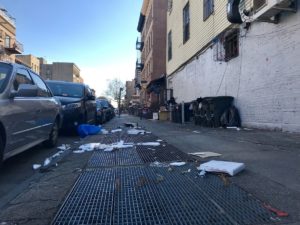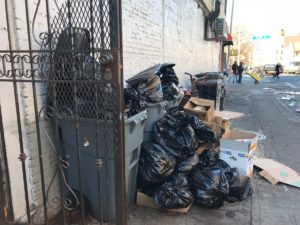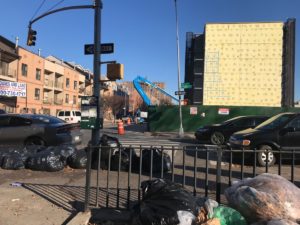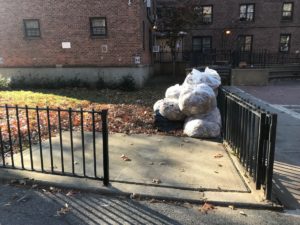Nostrand Avenue station, Bedford-Stuyvesant: With eight minutes to the next Queens-bound A train, a large rat emerges from the middle of the track and runs to the border wall of the Manhattan-bound side.
It rests there for a few seconds before heading back over the rails toward the Queens-bound side. There it nestles against an empty plastic soda bottle for a while, moves on to a MetroCard and then another bottle, then dashes back to the Manhattan-bound side where a smaller rat is perched. For a few seconds it looks like they are in intimate conversation. The large rat eventually disappears down the track, as the A train approaches.
Commuters at Nostrand Avenue on this sunny but cold weekday seem oblivious to the rodents rummaging through the tracks as they wait for the train, but they are fully aware of the rat menace that has plagued New York City and Bed-Stuy for decades. And despite Mayor de Blasio’s recent call for war on the rats of Bed-Stuy, they are doubtful about the chances for victory.
With 221 out of 1,687 properties in Bedford- Stuyvesant community district #3 failing rat inspections last year, according to data from the NYC Department of Health and Mental Hygiene, the neighborhood is one of the city’s three targeted highly infested rat zones, and will get part of a $32 million investment with a goal of seeing the rodents in the area reduced by 70 percent. The city’s war against the rats will start by the end of the year. But along with attacking the rats, Mayor de Blasio and his team will also have to tackle the skepticism of the public.
“The subways are a major harbinger of rats. There’s an infestation down there,” says Jeff Sherman, a Bed-Stuy resident and the owner of Marcy and Myrtle, a quaint coffee bar at the corner of, yes, Marcy and Myrtle Avenues.

With a Department of Health A-rating sticker on the glass door entrance of the coffee shop, which lets customers know there are little to no health violations at this establishment, Sherman says he takes all precautions to make sure he gets no rat activity at his restaurant. “I don’t keep the garbage here at night, I keep it round the corner.”
But the frequency of trash pickup is a challenge. On a Thursday afternoon, trash bags line almost every corner of Marcy Avenue. Trash pick-up days here are Mondays, Wednesdays, and Fridays. At 2 p.m. this Thursday afternoon, there is no sign the garbage will be picked up anytime soon.


A few meters away, in front of one of Bed-Stuy’s most famous housing complexes, Marcy projects, Curtis E., 58, sits on a stoop near the Marcy Avenue and Stockton Street T junction. He has a disability and needs a walker to get around, but he visits the neighborhood at least three times a week to see his 78-year-old mother. Though he lives in Staten Island now, Curtis grew up in the low-income housing complex, and says he has seen his fair share of rats in the neighborhood. He feels the area has long been neglected by the city.
Curtis is unhappy with how long trash bags are left on the streets, an obvious magnet for rats. Meanwhile, he points out, city workers are at Marcy homes picking bagged leaves around the complex. He does not believe the mayor’s plan will reduce the rat population here. With the aid of his walker, Curtis strolls through the back of several buildings to the parking lot of 21 Nostrand Avenue. He points out a precautionary sign: ‘Warning, keep away rat poison,’ it says. The sign is on the brick wall just above a dried out hedge. A closer look reveals a dozen rat burrows. Curtis says the rodents climb out of the holes as soon as it gets dark. “You’ll be thinking that they are squirrels but they are rats,” he said. “It’s sad.”



 All 27 buildings in the Marcy houses have been marked as showing active rat signs by city health inspectors. “It’s crazy. They’re everywhere,” says London Washington, a 30-year-old Chipotle restaurant manager who also lives in the area. “So many people are living on top of people. I was walking my dog the other day and they just ran in and out of the trash into the gutter. I don’t know what will solve the problem.”
All 27 buildings in the Marcy houses have been marked as showing active rat signs by city health inspectors. “It’s crazy. They’re everywhere,” says London Washington, a 30-year-old Chipotle restaurant manager who also lives in the area. “So many people are living on top of people. I was walking my dog the other day and they just ran in and out of the trash into the gutter. I don’t know what will solve the problem.”
But the city does have a strategy to reduce rat complaint calls from Beds-Stuy. The plan includes earlier trash pickups; Big Belly Trash Cans replacing wire trash baskets, in order to prevent the rodents from entering the garbage; hefty illegal dumping fine increases, from $1,500 to $5,000; and conversion of some public housing building basements from dirt to concrete floors.
Some experts are dubious about parts of it. According to Jonathan Auerbach—a Columbia University statistician who estimated the city rat population to be two million in a 2014 PhD study—$32 million is not enough to reduce the menace of rats in New York.
But “The infrastructure improvements are good and will to some degree reduce the population,” he said. According to Auerbach, the city will get the decline it is looking for, but the measures are not enough to see a citywide drop in the rat population of New York. “If there is a cultural change in the way we handle trash, recycle and reuse, then we will see a huge decline in the rat population.”
Auerbach is not the only expert who believes the New York rat problem is in essence a trash problem. Dr. Bobby Corrigan is a rodentologist and former research scientist with the city health department. He has studied rat populations for more than 20 years. “I like that some of the monies will address the crux of the issue: the bagged food trash staged on the curbs every night, overnight,” Corrigan said. “It’s no secret that this garbage practice of 8 to 12 million humans placing their trash in easy reach of the rats every night gives them enough protein to have large litters.
“And thus the logarithmic growth of Rattus populations,” he said. “It’s all about the trash. No food, no rats.”
The Department of Health and the mayor’s office did not respond to a request to comment on when the rat war will finally begin. Until then, the subway rat lives another day.


Leave a Reply